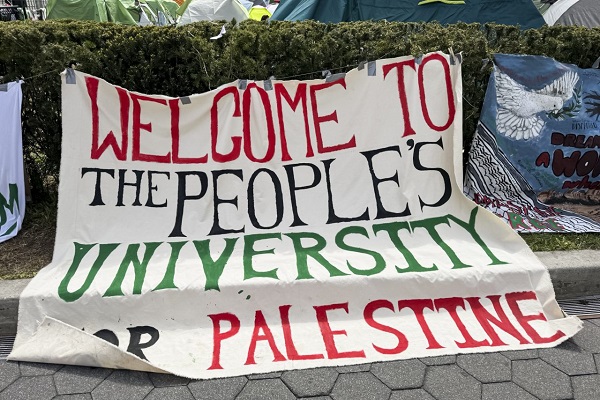Frontier Centre for Public Policy
No, Mr. Mayor outside organizers are not responsible for student radicalism

From the Frontier Centre for Public Policy
While there are malevolent outside actors doing what they can with universities, the influential corruption is internal.
In his May 1 press conference on the university student demonstrations, occupations, and riots, New York Mayor Eric Adams blamed outside professional organizers for radicalizing our young people in universities in New York, on campuses throughout the country, and around the world. Exactly who these sinister outside forces are, the mayor did not specify.
Of course, the mayor is correct that there are outside professional organizers and agitators who have infiltrated campuses and encouraged even more extreme measures by demonstrators. Everyone sees the uniformity across the country of materials provided, such as tents and signs.
Yes, these are malevolent forces bent on transforming or destroying the United States. But funders and organizers are facilitators and enablers, not primary motivators. Mr. Adams is right in saying that professionals are behind these upheavals. But outside agitators and funders are not shaping the hearts and minds of university students. Rather, the professionals responsible for students’ mindsets are not external to universities; they are the employees of universities, who have been working on the students, miseducating them, throughout their entire university careers.
The satirical website Babylon Bee gets it right. With reference to the occupation of the Columbia University administration building, the Bee article headline is “Oh No! Indoctrinated Woke Extremists Destroy Woke Extremist Indoctrination Center.”
Quoting an imaginary university official, the Bee stated: “‘We didn’t see this coming,’ said one official. ‘After spending decades brainwashing young, impressionable people into volatile, savage revolutionaries, we were shocked to see them unleash such volatility and savagery while trying to launch a revolution. We wish there had been warning signs along the way.’”
Would that this were only humorous parody. Alas, it is an accurate representation of our universities in the 21st century. The many professors who have joined the demonstrators-occupiers-rioters, and who knows how many administrators and staff, is proof of the nature of today’s education.
The Bee continued:
“Students who engaged in the violent attack were thankful for the years of intense training they received from the institution they were now actively working to destroy. …
“At publishing time, the school’s leadership was confident that the government would do nothing to impede their ongoing efforts to make the country worse and more dangerous.”
The many pleas from well-meaning observers for the occupiers to desist so that students can return to their classes are beside the point. Their classes are where they were radicalized. The faculty itself is almost entirely radicalized.
Left-wing university monoculture today is nothing like the Enlightenment-based university that I attended in the mid-20th century, where the emphasis was on searching for the objective truth of reality using reason, evidence, and well-founded conclusions. Universities have now rejected the search for truth in favor of activism based on far-left Marxist “truths,” which may not be questioned.
Among these “truths” is the certainty that all people in the world are divided between evil, ruthless oppressors and exploiters and innocent, noble victims. In this class conflict, which is the only important feature of human life, black, indigenous, and people of color (BIPOC), LGBT people, females, the disabled, and Muslims are all innocent victims of whites, Asians, and Jews, heterosexuals, males, the able, and Christians.
“Victims” are represented in universities by grievance subjects, which at first leaked into but then flooded the humanities and social sciences. Feminist, Black, Queer, Islamic, and Disabled Studies do not exist to investigate truth and reality but to advocate for the victims they represent, and to spur change to the advantage of their designated category.
As part of this project, one common belief among grievance subjects, and now the humanities and social sciences, is that Western civilization must be abandoned as oppressive, and Western countries, such as the United States and Canada, must be transformed entirely or destroyed. Anti-colonial studies “prove” that these countries are in any case invalid and that the American and Canadian citizens are “colonial settlers” without legitimate standing.
University administrators are not innocent victims of these trends. On the contrary, they are primary instigators. They impose the “diversity, equity, and inclusion” manifestations of the “social justice” ideology, leading to official implementation of reverse racism, reverse sexism, and segregation. Discrimination against “oppressors” is not only tolerated; it is also systematically imposed and celebrated.
While student bodies have remained consistent in size, and the professoriat has, if anything, shrunk, not to mention the increased reliance on untenured, temporary “sessional” lecturers (a great financial saving), administrations have exploded in size, increasing to double or triple in most universities. One source of this is “DEI officers,” hired at every level and in every unit, at huge cost, to serve as political commissars policing thought and speech, so that no one can deviate from politically “correct” belief and expression.
Any professor, lecturer, or instructor professing opinions not in line with “social justice” and radical change are quickly identified and surrounded by DEI commissars and forced to confess error, go to re-education programs, lose privileges of various kinds—forget promotion and funding—and, if stubborn in deviation, termination outright, and banishment from the university. This puts great power in the hands of students, who only have to say that they are offended by what a professor says, and she (more rarely he today) is on the chopping block.
So while there are malevolent outside actors doing what they can with universities, the influential corruption is internal. If you block the outsiders, nothing will change. The universities are the source of the radicalism.
Philip Carl Salzman is Emeritus Professor of Anthropology at McGill University and Senior Fellow at the Frontier Centre for Public Policy.
Business
It Took Trump To Get Canada Serious About Free Trade With Itself

From the Frontier Centre for Public Policy
By Lee Harding
Trump’s protectionism has jolted Canada into finally beginning to tear down interprovincial trade barriers
The threat of Donald Trump’s tariffs and the potential collapse of North American free trade have prompted Canada to look inward. With international trade under pressure, the country is—at last—taking meaningful steps to improve trade within its borders.
Canada’s Constitution gives provinces control over many key economic levers. While Ottawa manages international trade, the provinces regulate licensing, certification and procurement rules. These fragmented regulations have long acted as internal trade barriers, forcing companies and professionals to navigate duplicate approval processes when operating across provincial lines.
These restrictions increase costs, delay projects and limit job opportunities for businesses and workers. For consumers, they mean higher prices and fewer choices. Economists estimate that these barriers hold back up to $200 billion of Canada’s economy annually, roughly eight per cent of the country’s GDP.
Ironically, it wasn’t until after Canada signed the North American Free Trade Agreement that it began to address domestic trade restrictions. In 1994, the first ministers signed the Agreement on Internal Trade (AIT), committing to equal treatment of bidders on provincial and municipal contracts. Subsequent regional agreements, such as Alberta and British Columbia’s Trade, Investment and Labour Mobility Agreement in 2007, and the New West Partnership that followed, expanded cooperation to include broader credential recognition and enforceable dispute resolution.
In 2017, the Canadian Free Trade Agreement (CFTA) replaced the AIT to streamline trade among provinces and territories. While more ambitious in scope, the CFTA’s effectiveness has been limited by a patchwork of exemptions and slow implementation.
Now, however, Trump’s protectionism has reignited momentum to fix the problem. In recent months, provincial and territorial labour market ministers met with their federal counterpart to strengthen the CFTA. Their goal: to remove longstanding barriers and unlock the full potential of Canada’s internal market.
According to a March 5 CFTA press release, five governments have agreed to eliminate 40 exemptions they previously claimed for themselves. A June 1 deadline has been set to produce an action plan for nationwide mutual recognition of professional credentials. Ministers are also working on the mutual recognition of consumer goods, excluding food, so that if a product is approved for sale in one province, it can be sold anywhere in Canada without added red tape.
Ontario Premier Doug Ford has signalled that his province won’t wait for consensus. Ontario is dropping all its CFTA exemptions, allowing medical professionals to begin practising while awaiting registration with provincial regulators.
Ontario has partnered with Nova Scotia and New Brunswick to implement mutual recognition of goods, services and registered workers. These provinces have also enabled direct-to-consumer alcohol sales, letting individuals purchase alcohol directly from producers for personal consumption.
A joint CFTA statement says other provinces intend to follow suit, except Prince Edward Island and Newfoundland and Labrador.
These developments are long overdue. Confederation happened more than 150 years ago, and prohibition ended more than a century ago, yet Canadians still face barriers when trying to buy a bottle of wine from another province or find work across a provincial line.
Perhaps now, Canada will finally become the economic union it was always meant to be. Few would thank Donald Trump, but without his tariffs, this renewed urgency to break down internal trade barriers might never have emerged.
Lee Harding is a research fellow with the Frontier Centre for Public Policy.
2025 Federal Election
The Cost of Underselling Canadian Oil and Gas to the USA

From the Frontier Centre for Public Policy
Canadians can now track in real time how much revenue the country is forfeiting to the United States by selling its oil at discounted prices, thanks to a new online tracker from the Frontier Centre for Public Policy. The tracker shows the billions in revenue lost due to limited access to distribution for Canadian oil.
At a time of economic troubles and commercial tensions with the United States, selling our oil at a discount to U.S. middlemen who then sell it in the open markets at full price will rob Canada of nearly $19 billion this year, said Marco Navarro-Genie, the VP of Research at the Frontier Centre for Public Policy.
Navarro-Genie led the team that designed the counter.
The gap between world market prices and what Canada receives is due to the lack of Canadian infrastructure.
According to a recent analysis by Ian Madsen, senior policy analyst at the Frontier Centre, the lack of international export options forces Canadian producers to accept prices far below the world average. Each day this continues, the country loses hundreds of millions in potential revenue. This is a problem with a straightforward remedy, said David Leis, the Centre’s President. More pipelines need to be approved and built.
While the Trans Mountain Expansion (TMX) pipeline has helped, more is needed. It commenced commercial operations on May 1, 2024, nearly tripling Canada’s oil export capacity westward from 300,000 to 890,000 barrels daily. This expansion gives Canadian oil producers access to broader global markets, including Asia and the U.S. West Coast, potentially reducing the price discount on Canadian crude.
This is more than an oil story. While our oil price differential has long been recognized, there’s growing urgency around our natural gas exports. The global demand for cleaner energy, including Canadian natural gas, is climbing. Canada exports an average of 12.3 million GJ of gas daily. Yet, we can still not get the full value due to infrastructure bottlenecks, with losses of over $7.3 billion (2024). A dedicated counter reflecting these mounting gas losses underscores how critical this issue is.
“The losses are not theoretical numbers,” said Madsen. “This is real money, and Canadians can now see it slipping away, second by second.”
The Frontier Centre urges policymakers and industry leaders to recognize the economic urgency and ensure that infrastructure projects like TMX are fully supported and efficiently utilized to maximize Canada’s oil export potential. The webpage hosting the counter offers several examples of what the lost revenue could buy for Canadians. A similar counter for gas revenue lost through similarly discounted gas exports will be added in the coming days.
What Could Canada Do With $25.6 Billion a Year?
Without greater pipeline capacity, Canada loses an estimated (2025) $25.6 billion by selling our oil and gas to the U.S. at a steep discount. That money could be used in our communities — funding national defence, hiring nurses, supporting seniors, building schools, and improving infrastructure. Here’s what we’re giving up by underselling these natural resources.

342,000 Nurses
The average annual salary for a registered nurse in Canada is about $74,958. These funds could address staffing shortages and improve patient care nationwide.
Source

39,000 New Housing Units
At an estimated $472,000 per unit (excluding land costs, based on Toronto averages), $25.6 billion could fund nearly 94,000 affordable housing units.
Source
About the Frontier Centre for Public Policy
The Frontier Centre for Public Policy is an independent Canadian think-tank that researches and analyzes public policy issues, including energy, economics and governance.
-

 2025 Federal Election11 hours ago
2025 Federal Election11 hours agoThe Federal Brief That Should Sink Carney
-

 2025 Federal Election13 hours ago
2025 Federal Election13 hours agoHow Canada’s Mainstream Media Lost the Public Trust
-

 2025 Federal Election16 hours ago
2025 Federal Election16 hours agoOttawa Confirms China interfering with 2025 federal election: Beijing Seeks to Block Joe Tay’s Election
-

 2025 Federal Election15 hours ago
2025 Federal Election15 hours agoReal Homes vs. Modular Shoeboxes: The Housing Battle Between Poilievre and Carney
-

 John Stossel12 hours ago
John Stossel12 hours agoClimate Change Myths Part 2: Wildfires, Drought, Rising Sea Level, and Coral Reefs
-

 COVID-1914 hours ago
COVID-1914 hours agoNearly Half of “COVID-19 Deaths” Were Not Due to COVID-19 – Scientific Reports Journal
-

 Entertainment2 days ago
Entertainment2 days agoPedro Pascal launches attack on J.K. Rowling over biological sex views
-

 2025 Federal Election2 days ago
2025 Federal Election2 days agoPoilievre Campaigning To Build A Canadian Economic Fortress

